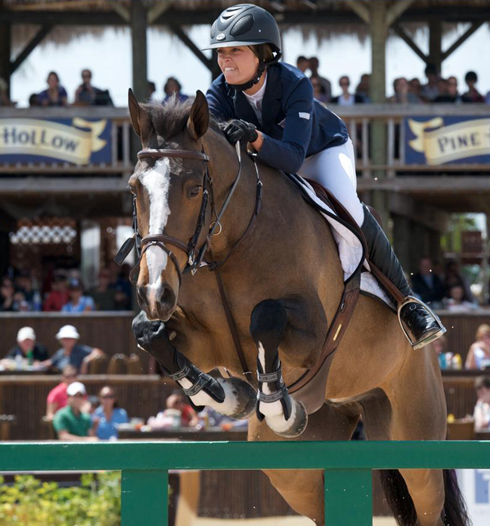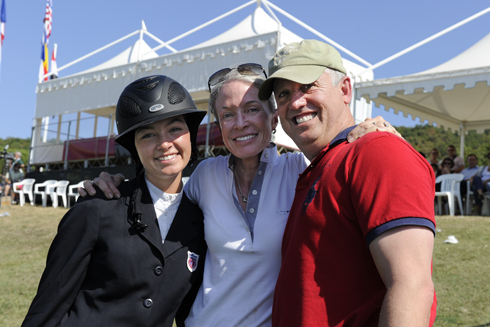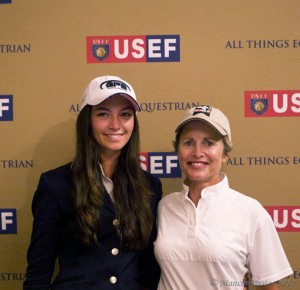Kessler, 17, Wows Jumper Crowd
By Paula Parisi March 26, 2012
Seventeen-year-old Reed Kessler is the youngest rider to make a play for the Olympic gold ring, and she got there on a horse that competed in her first grand prix only weeks before the trials. Not only did Kessler and her mare, Cylana, make the cut for try-outs, they were No. 1 on the USEF’s first ranked “long list” for the 2012 Olympic show jumping team, ahead of Margie Engle, with whom she tied for first at the USEF’s initial trials at the Winter Equestrian Festival in Florida.
That could have something to do with the fact that she and her second horse, Mika, were among the trio of riders to get the second-best score of the WEF trials. “This is the best week of my life,” Kessler said shortly after the conclusion of the four-round trial series at the Palm Beach International Equestrian Center Saturday.
“I can’t even believe I’m sitting here,” the teen said at the press conference following the event. “I was just looking forward to having a really positive first experience and so far it has been that.” Kessler not only split the winner’s share of the $200,000 prize with Engle, she also earned the title National Champion.
“Reed’s goal has always been to be a top international rider and to represent her country,” said her father, Murray Kessler, who was once an active competitor in the amateur-owner ranks and still competes in the Masters divisions. Her mother, Teri, was a top hunter rider who now successfully competes in the A/O jumpers.
The family maintains Kessler Show Stables in Armonk, NY, and Reed—who attends Manhattan’s Professional Children’s School, where the curriculum is tailored to kids with careers—won the USEF Junior Jumper National Championship in Harrisburg in 2009 (1.45m), then went on to an impressive list of successes both here and abroad, including the blue in the $40,000 Land Rover Grand Prix CSI2* at the Gucci Masters in 2010 and the $31,000 1.50m Speed Class at the Washington International Horse Show in 2011.
Her godmother, the Virginia-based Katie Prudent, is also her on-the-road trainer (along with husband Henri Prudent); when Kessler competes in Europe she rents space at their barn in Rosiere aux Saline, France. “This isn’t a hobby for her,” continued Murray Kessler (who was Prudent’s first student 36 years ago). “It’s in her blood. This Olympic Selection Trials is an important step in a long-term process.” In fact, the straight-A student is putting college plans on hold to pursue her dream of an athletic career.
Despite all that, the young Kessler–who in July turns 18, the minimum age for Olympic equestrian competition (“and for anything above a CSI2*,” Murray noted)–is tamping down her expectations.
“I think it would be unrealistic of me to expect to be on the [2012 Olympics] team,” she said in Florida. “I have no experience and Cylana and Mika are both relatively green at this level too. From here on in, I’ll do whatever (chef d’equipe) George (Morris) tells me and I’ll do my very best. I can’t predict any further because I could not possibly have predicted this!”
But for Kessler, defying expectations is becoming the norm. “Technically, Kessler won the [WEF Olympic] trials, since she jumped more clean rounds than Engle—she and Cylana jumped clean in Round 1 and 2, while Engle and Indigo had one clean round in Round 1,” wrote Molly Sorge in The Chronicle of the Horse, calling the fact that the teenager found herself on top at the end of the week “one of the biggest upsets in show jumping.”
Unlike Mika, a 12-year-old Selle Francais gelding she’s owned since he was 8, Kessler only started riding Cylana five months ago. Describing the 10-year-old Belgian Warmblood (Skippy II x Darco) as “an over-scoped equitation horse,” she joked that the horse is “so easygoing” as to have almost no personality. (In her placid nature, she is not unlike McLain Ward’s mare Sapphire, to whom she is related through the Darco line).
Cylana was purchased from Swiss dealer Gerhard Etter last summer, when Kessler was competing on the European Young Riders Tour. “They are horse dealers that the Prudents have had a relationship with for over 30 years,” Murray explained. “The Etters found Cylana in the 1.30m jumper division and told us we needed to come look at her because they thought she could jump much bigger. We were actually looking for a speed horse. When we got there, she was basically overweight and lazy, but could jump some bigger jumps easily, so we bought her.”
Reed spent the end of last year getting the mare “very fit and trim.” But before she got to Florida for the winter circuit, she had never jumped her over 1.40m. “When we got to Florida we did a few 1.40m classes then put her into her first grand prix in February. She kept doing it easily and won a grand prix by week six.”
Cylana broke the 1.60m barrier in a World Cup qualifier just two weeks before the trial. “She did that easily as well, so we put her in the trials and the rest is history,” Murray Kessler summed up. “Reed calls her an ‘over-scoped equitation horse’ because she goes around the course so smoothly and calmly. Lots of people tell her she looks like she is riding in an equitation class that just happens to be 1.60m. Part of this amazing story is really that not only was this Reed’s first time doing something of this magnitude, it was also Cylana’s.”
“She is really so smart and so brave and so game for anything―riding her is just effortless,” Reed Kessler said (modestly under-estimating her own role in the equation). We moved her up and moved her up and she never once struggled, so we just kept moving her up.”
After clear rounds in Trial 1 and Trial 2, Kessler picked up eight faults in Trial 3, which was held the evening of the second test. She described that course, built by Ireland’s Alan Land, as “massive.” After a day off, Trial 4 was also at night, and Kessler and Cylana had a rail at the last jump, an oxer.
Kessler said the lights got her “a little excited.” Cylana had only done one other night class prior to this, and Kessler said she “didn’t expect her to be as fresh as she was with all the jumping she’s done.” Stamina will count for a lot at the Olympics, where the gargantuan courses are 500-600 meters long (one-third to just under a half-mile), with jumps between 1.50m-1.60m (4’ 11” to 5’3”) high, with spread of up to 2.0m (6.5’), traversed at a required speed of 375 meters (about a quarter mile) per minute (at previous Olympics the speed was 400 meters-per-minute, but it has been reduced for the London Games).
At the end of the day, performance will count for a lot, but it will ultimately be up to the Olympic show jumping selectors—Morris and rider/trainers Chris Kappler, Susie Hutchison and Mark Leone—as to who makes the team. They are working with a system tailored specifically to this year’s trials, and while it appears to be based largely on absolutes—clear rounds, time, a horse’s fitness—there is a certain “gut” factor that will no doubt come into play. Because while it may not be a horse race, it’s pretty darn close!
Short URL: https://theequestriannews.com/?p=9280






